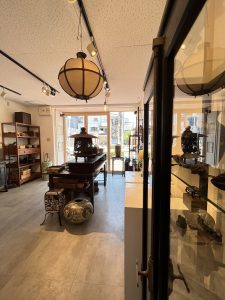帝室技芸員 高村光雲(愛知県名古屋市千種区姫池通 骨董買取 古美術風光舎)
2024.08.29
皆さまこんにちは、スタッフYでございます。

ここ名古屋でも今朝から雨が降っておりますが、皆様の地域は大丈夫でしょうか。今回の台風は人間のジョギング並みのスピードということでらしく台風疲れも致しますが、すでに九州などでは被害も出ております。お見舞いを申し上げますと共に、ゆっくりですので台風がこれから来る地域では備えを万全にしておきたいものです。
さてさて、忘れた頃にやってくる「帝室技芸員」シリーズ。
本日は「高村光雲」についてつぶやいてみようかと思いますので、少しお付き合いくださいませ。
高村光雲(たかむらこううん)は、明治から大正時代に活躍した著名な仏師、彫刻家でありますが、美術の教科書か何かで目にして記憶にある方も結構いるのではないでしょうか。有名な作品ですと「老猿」が、国の重要文化財に指定されております。

(国立博物館HPより)
ほかにも有名な作品があるのですが、ここでクイズ。それはなんでしょう?。
ヒントは皆さんご存知のあの有名な銅像なのですが。もう答えを言ってしまいますと「上野の西郷さん」と呼ばれ、現在もなお人々から親しまれる上野公園の西郷隆盛像であります。
余談ですが西郷隆盛は大の写真嫌いだったようで、どうもあの像は弟の西郷従道や従兄弟の大山巌をモデルにしたと言われており、像の除幕式の際には妻のイト夫人が「こがな人じゃなか」と発言し、色々あったようですね。いかんせん写真がなかったようですので、その点では作家高村光雲の苦労と困惑に少々同情してしまいます笑。
また、丸の内の皇居前広場にある、楠木正成像の制作者(他の作家と共同制作)も高村光雲の作品なのですが、このような大作を手掛けている高村光雲ですが、その経歴は才能や努力もあったでしょうが、いわゆる「もってる人」のようにも思えます。
高村光雲の主な経歴は以下のようでして
1852年 江戸で生まれる
1863年 仏師・高村東雲に師事する
1877年 第一回国内勧業博覧会で龍紋賞を受賞
1886年 東京彫工会を設立する
1890年 「帝室技芸員」に任命される
1893年 シカゴ万国博覧会に『老猿』を出品する
1898年 上野公園『西郷隆盛像』の木型制作する
1899年 木彫レリーフ『江口の遊君(遊女)』を制作する
1919年 パリ万国博覧会に『山霊訶護』を出品する
1934年 逝去(満82歳)
高村光雲が生まれたのは、ペリーが浦賀に来た黒船来航の前年。もともと大工の弟子になる予定でしたが、奉公に出される前日、行きつけだった床屋からの紹介で、仏師の高村東雲(たかむらとううん)の弟子になります。そして後に東雲の姉・エツの養子となり、ここで高村姓になります。このころは絵画や彫刻などをはじめとする芸術は、限られた富裕層のみが楽しむものでありました。
ですが、明治維新以後、廃仏毀釈運動の影響により仏師は仕事があまりなくなってしまい、光雲自身の生活も苦しかったようです。しかし、そのような状況の中でも、光雲は木彫に専念し、積極的に西洋美術を学び、写実主義を取り入れることで衰退しかけていた木彫を復活させ、江戸時代までの木彫技術の伝統を近代につなげる重要な役割を果たしていきます。
その後、1889年には東京美術大学に勤務し、1890年には「帝室技芸員」に任命されています。ここでようやく出てきましたね、「帝室技芸員」。
「帝室技芸員」とは、戦前の日本で宮内省によって運営されていた、美術家や工芸家の顕彰制度であり、優秀な美術家・工芸家に、帝室からの栄誉を与え保護し、日本美術・工芸の保護奨励を目的に設置された制度。(お伝えしておりましたが)その待遇や役割としては帝室技芸員には年金が支給され、制作を下命されることもあり、技術に関する諮問を受けることなどが定められておりました。
いうなれば人格・技量ともにすぐれた者が任命され、皇室の美術・工芸品制作を勅命で行ったり、博物館総長の諮問に応じたり、といった任務が与えられた「栄誉職」であります。
それにしても光雲の生家は貧しかったため、紹介がなければ彫刻家の道を歩むことはなかったでしょうし、努力や才能もあったでしょうが、こんな選択肢が目の前に現れ、それを選んだということはたしかに「もってる人」なのか。いや、まてよ。そもそもどの道にすすんでも「もってる人」になれる人格や技量のある人だったかもしれないし…。どっちなのか…。
そんなことを光雲作品を眺めながらぐるぐる考えるもってない人(スタッフY)の、今朝でありました。
それではごきげんよう。
Hello everyone, this is Staff Y.
It has been raining here in Nagoya since this morning. This typhoon is as fast as a human jogger, so you may feel typhoon fatigue, but there is already damage in Kyushu and other areas. I would like to express my condolences to those who have been affected by this typhoon, and I hope that those who are in the area where the typhoon will be coming soon will be prepared for it.
Now, I have been posting “Imperial Household Artists” series as soon as I forget about them. Today, I would like to write about “Koun Takamura,” so please bear with me for a moment.
Takamura Koun was a famous Buddhist priest and sculptor active from the Meiji to Taisho periods. One of his famous works, “Old Monkey,” is designated as a National Important Cultural Property.
There are other famous works, but here is a quiz. What is it?
The clue is that famous bronze statue that you all know. The answer is the statue of Takamori Saigo in Ueno Park, called “Saigo-san of Ueno” and still loved by people today.
As a side note, it is said that Saigo Takamori was a great averse to photographs, and that the statue was modeled after his younger brother Saigo Cudamichi and his cousin Oyama Iwao. In the end, there were no photographs of the statue, so I feel a little sympathy for the artist Takamura Koun’s hardship and embarrassment in this regard.
Also, Koun Takamura was the creator (in collaboration with other artists) of the statue of Masanari Kusunoki in the plaza in front of the Imperial Palace in Marunouchi, and although he may have had talent and hard work in his career, he seems to have been what is called a “possessor”.
Koun Takamura’s main biography is as follows
1852 Born in Edo, Tokyo
1863: Studied under the Buddhist priest Toun Takamura
1877 Awarded the Ryumon Prize at the first National Industrial Exhibition
1886 Founded the Tokyo Engraving Society
1890 Appointed as an “Artist to the Imperial Household
1893 Exhibited “Old Monkey” at the World’s Columbian Exposition in Chicago
1898 Produced the wooden model for the statue of Takamori Saigo at Ueno Park
1899 Produced the wood relief “Eguchi no Yuukin (prostitute)
1919 Exhibited “Sanrei Kago” at the Universal Exposition in Paris
Died in 1934 at the age of 82.
Koun Takamura was born the year before Perry’s arrival of the black ships at Uraga. He had originally planned to become a carpenter’s apprentice, but the day before he was to be sent on apprenticeship, he was introduced by his favorite barber to become the apprentice of a Buddhist priest, Takamura Toonun. He later became the adopted son of Etsu, Toonun’s sister, and took on the Takamura family name. At that time, art, including painting and sculpture, was enjoyed only by a limited number of wealthy people.
However, after the Meiji Restoration, the movement to abolish Buddhism left Buddhist monks without much work, and Koun himself had a difficult time making a living. However, even under such circumstances, Koun devoted himself to woodcarving, actively studying Western art and adopting realism to revive woodcarving, which was on the verge of decline, and played an important role in connecting the tradition of woodcarving techniques up to the Edo period to the modern age.
Later, in 1889, he worked at the Tokyo National University of Fine Arts and Music, and in 1890, he was appointed as an “Imperial Artist. Here it finally appears: “Imperial Household Artistician.
The “Imperial Household Artists” was a system operated by the Ministry of the Imperial Household in prewar Japan to honor artists and craftsmen, and was established to protect outstanding artists and craftsmen by honoring them with imperial honors, and to protect and promote Japanese arts and crafts. (The system was established to honor and protect outstanding artists and craftsmen from the Imperial Household and to protect and promote Japanese arts and crafts.
In other words, it was an “honorary position” for people of outstanding character and skill to be appointed, and they were given such duties as producing works of art and crafts for the Imperial Household by imperial order and consulting with the Director General of the Museum.
Koun’s family was poor and he would not have become a sculptor if he had not been introduced to it, and he would have had to work hard and be talented, but to have such an option appear in front of him and he chose it, is he indeed a “possessive” person? No, wait. He may have had the personality and skills to be a “person of talent” no matter which path he took…. Which is it?
This is the morning of the person who has nothing (Staff Y), thinking about such things while looking at Koun’s works.
Have a good day.
*******************
ご実家の整理やお片付けなどをされている方のご相談などが多くございます。
お片付けなどくれぐれもご無理のないようになさってくださいませ。
風光舎では古美術品や骨董品の他にも絵画や宝石、趣味のお品など様々なジャンルのものを買受しております。
お片付けをされていて、こういうものでもいいのかしらと迷われているものでも、どうぞお気軽にご相談下さいませ。
また風光舎は、出張買取も強化しております。ご近所はもちろん、愛知県内、岐阜県、三重県その他の県へも出張いたします。
なお、毎月21日の持込鑑定会では無料鑑定・買取・ご相談など、ご予約なしで承っております。
ご近所の皆さま、ご遠方のみなさまも、お気軽にお越しくださいませ。
まずは、お電話お待ちしております。
愛知県名古屋市千種区姫池通
骨董 買取【古美術 風光舎 名古屋店】
TEL052(734)8444
10:00-18:00 OPEN
#出張買取#骨董#古美術#骨董品#絵画#版画#茶道具#刀剣#彫刻

